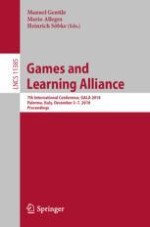2019 | Book
Games and Learning Alliance
7th International Conference, GALA 2018, Palermo, Italy, December 5–7, 2018, Proceedings
Editors: Dr. Manuel Gentile, Mario Allegra, Dr. Heinrich Söbke
Publisher: Springer International Publishing
Book Series : Lecture Notes in Computer Science
